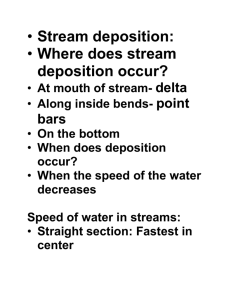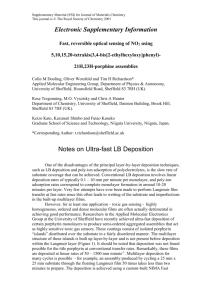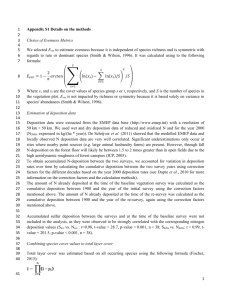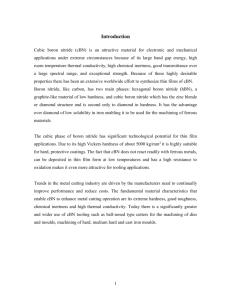Thin film deposition techniques
advertisement
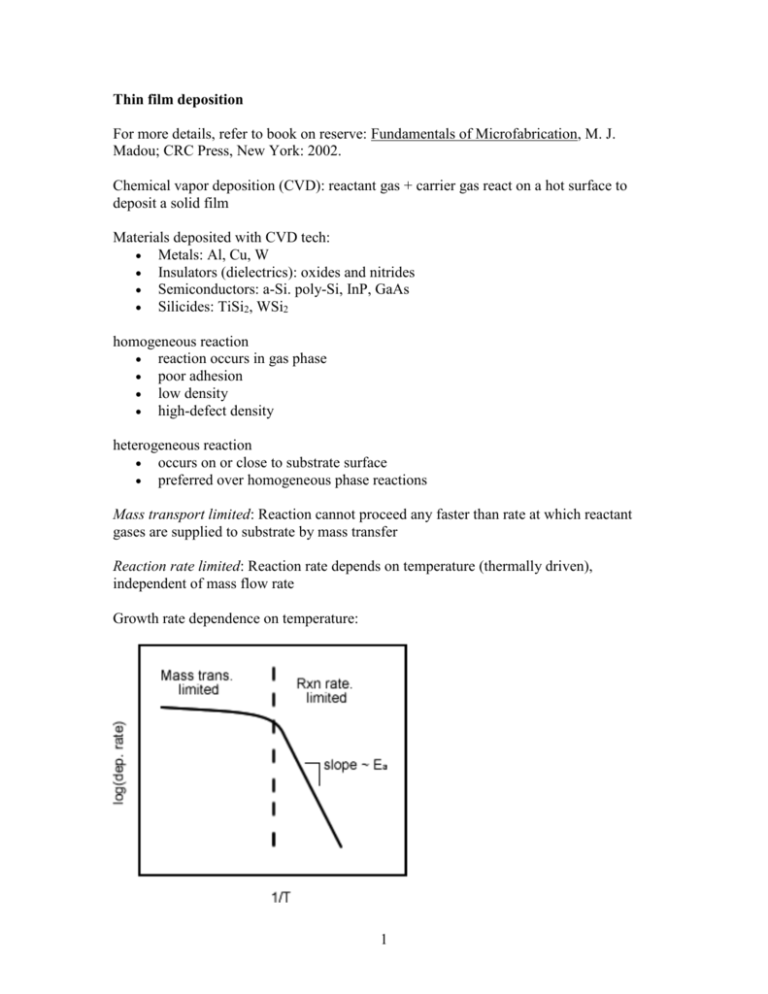
Thin film deposition For more details, refer to book on reserve: Fundamentals of Microfabrication, M. J. Madou; CRC Press, New York: 2002. Chemical vapor deposition (CVD): reactant gas + carrier gas react on a hot surface to deposit a solid film Materials deposited with CVD tech: Metals: Al, Cu, W Insulators (dielectrics): oxides and nitrides Semiconductors: a-Si. poly-Si, InP, GaAs Silicides: TiSi2, WSi2 homogeneous reaction reaction occurs in gas phase poor adhesion low density high-defect density heterogeneous reaction occurs on or close to substrate surface preferred over homogeneous phase reactions Mass transport limited: Reaction cannot proceed any faster than rate at which reactant gases are supplied to substrate by mass transfer Reaction rate limited: Reaction rate depends on temperature (thermally driven), independent of mass flow rate Growth rate dependence on temperature: 1 Description of reaction limited regime: Arrhenius relationship: r Ao exp( Ea / RT ) r: reaction rate T: temperature R: gas constant Ao: constant Ea: Activation energy Energy is needed to drive a reaction. Sources of energy: thermal – most common photons electrons Plasma source ions Plasma basics Plasma (with regard to fabrication techs): area of high energy electric and magnetic fields that rapidly dissociate a feed gas to produce radicals, neutrals, electrons, ions, and photons. Generating a plasma (glow discharge: weakly ionized) Apply a high voltage potential between two electrodes (dc-discharge) Apply a radio-frequency (RF) voltage between two electrodes. Free electrons collide with gas molecules – easier to sustain than dc-discharge Plasma density: number of charged species/unit volume RF plasma density: ~109 /cm3 Inductively coupled plasma (ICP) systems: uses ICP power source for creating highdensity (~1011/cm3), low-pressure and low-energy plasma Plasma-enhanced chemical vapor deposition (PECVD) – high density plasma provides additional source of energy allowing for deposition at relatively lower temp. (~300 °C) Provides good step coverage High deposition rates (~100 nm/min) Non-stoichiometric films can be made (SiNx) VINSE PECVD Silicon Lab: SiO2, SiNx, SiOxNy, a-Si Carbon Lab: diamond, carbon nanotubes 2 Process parameters and film properties Reaction pressure o ↓P, ↑ion bombardment: ↑film density, ↑film quality; ↓compressive stress, ↓ deposition rate o ↑P: ↑gas phase reaction and defect density RF frequency – use to control film stress and density; typically no control RF power o ↑Power: ↑deposition rate and ↑ion bombardment, thus film density Temperature – influences deposition rate and structure o Reaction rate limited regime: ↑T: ↑deposition rate o ↑T: crystalline structure o ↓T: amorphous structure Flow rate o increase flow to operate in reaction rate limited regime o change film stoichiometry by changing flow ratio of reactants Physical Vapor Deposition (PVD) – Deposition technique in which some form of energy is used to transfer material from target to the substrate, where it condenses. Types of PVD Evaporation o Thermal evaporation o Electron beam evaporation Sputtering Pulsed laser deposition Evaporation Some source of energy is used to vaporize material to be deposited Deposition rate depends of vapor pressure of material Reasonable deposition rate obtained for temperature at which vapor pressure is at least 10 mTorr Refractory metals (W, Ta, Mo, Ti) need to be heated in excess of 3000 °C Deposition is line-of-sight (good for use with masks) Thermal evaporation Heated filament used to boil off material Depositing alloys is difficult Poor adhesion Poor step coverage Not possible for refractory metals (limited choice of materials) 3 Electron beam evaporation High intensity electron beam focused on target material causes evaporation Deposition rates (10’s nm/min) Wider choice of materials Higher purity films Can cause x-ray and/or ion damage to substrate VINSE E-beam evaporator: Al, Au, Ag, Cr, Co, Mo, and others…. Lower deposition rate increases uniformity, but increases risk of contamination Pulsed laser deposition Like e-beam evaporation, but laser is used instead for removing target material Wide choice of target materials High purity Slow dep. rates Sputter deposition Plasma creates ions that are accelerated toward target. Momentum transfer from ions to target causes target material to be ejected toward surface (sputtering), where it condenses High purity films over large area are possible Just about any material can be sputtered – including compounds, but used mainly for metal deposition Changing target material is difficult Better step coverage than evaporated films, but not always as smooth Deposition rate: 10’s nm/min VINSE sputter tool: Al, Mo, Hf, and V 4





